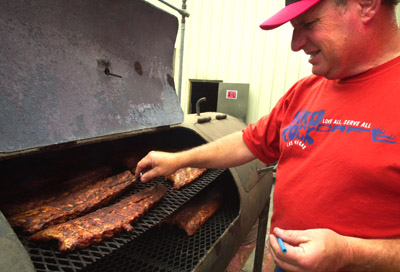
The aroma of meat searing on a barbecue grill means it’s
summertime, as smoky food on a hot summer day causes mouths to
water. Fire up the grill and invite the neighbors.
By Amanda Smith
Special to the Free Lance
The aroma of meat searing on a barbecue grill means it’s summertime, as smoky food on a hot summer day causes mouths to water. Fire up the grill and invite the neighbors.
And if you follow some tips from Hollister’s culinary experts, a delicious time will be had by all.
Barbecue fanatics Gary Goularte and Jon Mansmith agreed the key to success in any barbecue situation is simple – never rush. The meat ends up tough and usually bland, and spices become overpowering and ruin the dish, according to the local experts.
If someone has never set foot near a barbecue, Goularte recommended two books – “The Thrill of the Grill” and “Smoke and Spice.” Both are available at Barnes & Noble or Dorothy McNett’s Place.
Goularte also recommended hands-on experience at nonprofit organizations’ events, such as those at schools, club events and local churches. They are much more forgiving than the family if mistakes are made, he said.
Mansmith suggested using the Internet as a resource for cooking knowledge.
“The Internet is a wonderful tool,” he said. “Enter the word ‘barbecue’ and hundreds of recipes, tips and products are at your fingertips.”
While Goularte and Mansmith have both worked the grill for nearly three decades, they said the best way to learn is through trial and error.
“If you never try something new, you never find anything better.” Goularte said.
A mistake Mansmith once made turned into a popular and flavorful barbecue paste, which is available at most local grocery stores and is now diluted with the chef’s favorite liquids – beer, wine and water.
Mansmith’s also produces a famous dry rub, which he said is useful for most poultry, beef or even kabobs. The quality of rubs should never be compromised, he said.
Goularte said people should try new ideas and develop something that complements their taste buds. And using sauces and marinades is not as hard as most people think, he said.
Start off with an acidic ingredient such as alcohol, lemon juice, vinegar or a juice and add herbs, seasonings and oil. He said steaks should be marinated for a few hours or overnight, and chicken usually requires at least 24 hours.
“Be careful when marinating any poultry because meats such as chicken will absorb the flavor which is not necessarily a good thing.”
All meats in marinade should be turned over to infuse equal flavor over the entire meat, he said. Whether it is filet mignon, prime rib or fish, marinades and dry rubs can “make or break” a dish, he said.
Entrees are also an important ingredient to success. With chicken or beef, the local experts said beans and garlic bread are the most popular choices. Some people opt for corn or homemade fruit or vegetable salad to complement tastes.
If a dish is spicy, they suggested a sweet sauce to counteract the flavor for the not-so-bold eater.
But if the dish is mild, Goularte and Mansmith said to use a sweet-and-spicy or sweet-and-sour sauce. Goularte suggested using a favorite salad dressing to base a marinade or sauce.
“Plain live cultured yogurt can also serve as a sufficient base,” he added.
When striving for perfection, make sure to use “Grade A” products to achieve rich and decadent meals, they said. Generic or old products will not taste nearly as good.
“Never cut corners!” Goularte said.
If using beef, Mansmith prefers San Benito County favorite tri-tip for its versatility. If there is any leftover, it can be used in a stew or a stroganoff, he said. Tri-tip is also very juicy and tender when prepared and cut correctly.
Goularte said his favorite cut is a rib-eye steak. If prepared correctly, it will be deliciously tender and juicy, he said. If using tri-tip or large chunks of meat, cook entirely through and cut it as people come. He said it is also wise to provide variable-sized chunks.
When checking whether the meat is finished, Mansmith and Goularte agreed a thermometer is the best measuring stick. It is not only the safest and most accurate, but it also takes much less effort. Thermometers, they said, should read 140 degrees for most beef, 180 degrees for pork, 180 degrees for boneless chicken and 185 degrees for chicken with bones. They said the best way to know is to read directions on the package or ask your local butcher.
And they said the ongoing battle between propane or charcoal will probably never die. Both methods reap benefits and problems.
If you have ever tried meat from Mansmith’s or eaten some of Goularte’s choice cuts – and enjoyed the flavor – then opt for mesquite oak chips or logs. Charcoal, while it can provide great smoky flavor, may contain petroleum, so always look at the bag before purchasing and decide what flavor you desire.









